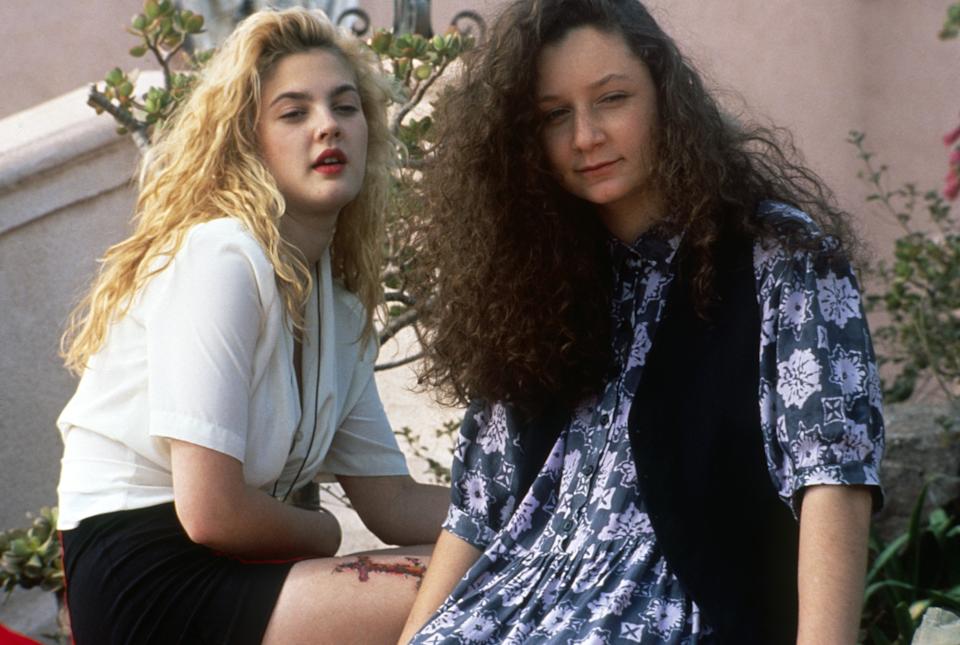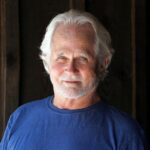Kid actors — they grow up so fast. When multiplex audiences first met Drew Barrymore, she was a cherubic six-year-old scene-stealer in Steven Spielberg’s 1982 family blockbuster, E.T. the Extraterrestrial. Ten years later, the sixteen-year-old star gave those same moviegoers a serious case of whiplash when she appeared as a teen seductress in Poison Ivy, which premiered in theaters on May 8, 1992. Written and directed by Katt Shea, the erotic thriller marked Barrymore’s return to the big screen after a series of career setbacks and a highly publicized struggle with drugs and alcohol.
That kind of baggage might have scared away another director, but Shea tells Yahoo Entertainment that it only made her more convinced that Barrymore was her Ivy, a sultry high-schooler who moves in with her best friend, Sylvie (Roseanne star Sara Gilbert), and proceeds to make herself a little too at home. “I thought her baggage was perfect for the role,” says the 63-year-old filmmaker, who got her start directing ’80s-era Roger Corman productions like Stripped to Kill. “What I was worried about was whether she could hold it together, because of what she went through as a tween. But she did great! She’s an absolute pro, and that’s been proven many, many times over.”
Barrymore’s Lolita-like makeover raised eyebrows ahead of Poison Ivy‘s release. And those eyebrows shot up even further when viewers saw the film’s trailers, which sold it as Fatal Attraction for the high school set — complete with torrid sex scenes that paired her with a much older actor, Tom Skerritt, who played Sylvie’s father, Darryl, whose marriage with invalid wife, Georgie (Cheryl Ladd), is on the rocks. The Top Gun scene-stealer was in his late 50s when the film was shot, and Shea says that he had serious concerns about filming intimate moments with an actress forty years his junior. “He told me at one point: ‘I could never do this with another director.’ I guess it’s because I had a sense of humor about it. We tried to make it fun and not serious, and I think he appreciated that.”
In contrast to Skerritt, Shea remembers that Barrymore was game for anything. “Drew was as happy as could she,” the director says, adding that the actress was sober throughout the Poison Ivy shoot. “She was just like, ‘Oh boy, let’s do it!’ Meanwhile, Tom is going: ‘Oh my god, oh my god.’ His discomfort is so palpable in the film.”
[embedded content]
Barrymore had so few inhibitions about the sex scenes that Shea felt the need to be “really protective” as a result — which frustrated her star. “She was like, ‘Stop it, Katt, stop.’ She thought it was ridiculous. I think it was all just very easy for Drew: she figured the character out right away and was able to channel that energy. She wanted to prove herself and show the world the professional actor and person that she is. Poison Ivy was a big opportunity for her to do that and to leave the whole little kid thing behind.”
Shea says that she used body doubles for some of the movie’s more explicit moments, like a rain-soaked love scene between Ivy and Darryl. But she’s well aware that the age gap in those scenes would make Poison Ivy a non-starter in contemporary Hollywood, no matter how many intimacy coordinators or body doubles were involved behind the camera. “I don’t think that movie would be made today, period,” she notes, adding that her 2017 novel, Bats*** Black, is closer to the way she’d approach Poison Ivy now. “That story could get made because it’s not about an older man — it’s really about those two girls.”
Seen again thirty years later, Sylvie and Ivy’s relationship — which exists at the crossroads of love and obsession — is the beating heart that powers Poison Ivy, and clearly inspired such subsequent edgy teen favorites as Cruel Intentions and Jennifer’s Body. And Shea confirms that the movie is, in part, a coming-out story, one that was released at a time when mainstream Hollywood was still struggling to incorporate LGBTQ narratives.
“I think Sara’s character was gay, and just coming into herself,” she explains. “They were friends first, but Sara fell in love with Ivy as everybody did. She managed to seduce everyone.” (Appearing on Barrymore’s talk show last year, Gilbert — who came out in 2010 — revealed that her co-star was her first “girl kiss” as part of the preparation for a kissing scene that doesn’t appear in the film.)
In a wide-ranging conversation, Shea — whose recent credits include more family-friendly fare like Nancy Drew and the Hidden Staircase and Rescued by Ruby — reveals the real-world origins of Poison Ivy, why the film started shooting without an ending and her biggest regret about the film … besides the many direct-to-video sequels it spawned.
As I understand it, Poison Ivy is based on a true story?
Correct. It’s based on the experience of Melissa Goddard, who was the executive producer of the film. The story is true in spirit, not in actual fact. For example, her mother was sick like Georgie, but Ivy didn’t actually kill her. And the real Ivy also didn’t die in the end! Melissa and [producer] Peter Morgan were partners on it and brought it to New Line [Cinema] and they handed it over to Andy and I. Originally, it was a Hollywood-set story because Melissa’s stepfather was a Hollywood producer, but we wanted to take it out of that realm because it made it kind of cheesy. Like Barbra Streisand was coming over to her house and stuff. We wanted to keep it really real and have it be something relatable, which it wouldn’t be in those Hollywood terms. I mean, I know loads of celebrities and that still feels unreal!
The film came out in an interesting era for erotic thrillers: Fatal Attraction had been a big hit a few years prior and Basic Instinct had just opened in March. All of those films were directed by men — was there something you wanted to bring to the genre as a female filmmaker?
I never considered myself a female filmmaker, so I don’t even know how to answer the question. That never even entered my mind. I did notice that everybody else was male — it was hard not to notice that. But I was very naive about it. After Poison Ivy, everybody in Hollywood knew my name, but I didn’t work for six years and it had to do with the fact that I was female. People said, “We want to be in business with you,” and then nothing came to fruition. It was so obvious and yet also so covert. At one point, my agent did tell me, “Male stars don’t want to be directed by women. They love your work and think you’re fantastic, but they don’t want to be directed by a woman.” She just put it right on the table.
In terms of casting, was Drew Barrymore always your first choice for Ivy?
She was the first choice — we just didn’t know if it was going to work out. We didn’t know if she even acting anymore, because she had been gone for quite a while. But she seemed so perfect for it. And Sara Gilbert, too. I had Sara in my mind for Sylvie when Andy and I were writing.
What was your first meeting with Drew like?
She stood me up twice! [Laughs] And then the third time I said, “I don’t want to see her,” but her agent begged me so she ended up coming to my house. Here’s the thing: she had been gone from the media at all, so I didn’t even know what she looked like at that point. She was 16 years old, and I had no idea what she looked like! When I did see her, she was beautiful. She looked so angelic, and I just thought, “Wow, I would not even recognize her as the little girl from E.T.” She could walk down the street with Sara Gilbert and everybody would stop Sara, but they didn’t even know who Drew was.
Were there specific things you talked to her about on set in terms of playing her first grown-up role?
I just always treated her like an adult. I tend to do that with kids anyway: I treat them all like they’re 30 and they like it, you know? I ask them how they feel. I don’t want to hear how their parents feel — I want to know how they feel about things. And it’s such a fun role to be the bad girl. In real life, of course, it’s not rewarded, but when you play a part like that in a movie, everybody is like, ‘Yay!” The worse you are, the more people like it.
Sara Gilbert doesn’t get to cut loose in that way. What was her process in approaching the role of Sylvie?
She kind of embodies us all right, right? Someone who is insecure, and doesn’t think she can make it. And Sara was actually like that. She told me, “I don’t think I can play this part.” Even though she was on Roseanne and stole every scene she was in, she didn’t think she could do it! I was just very supportive and helped her live through it. She’s perfect in the part, so adorable and innocent. And the second she and Drew met, it was magical; it was like kittens just starting to play. I didn’t need to do anything — they were just chatting away and laughing, talking about all their mutual friends.
There’s a piece of narration in the film where Sylvie suggests she’s a lesbian, but then immediately walks that back. Did New Line push back against having an out gay main character?
No, not really. The only reason it’s qualified is because the character herself wasn’t sure who she was yet. She’s young and figuring it out. Melissa Goddard’s been in a relationship with her partner for 26 years now, so that was never a question in our heads. I don’t remember any studio pushback; there may have been, but I ignored it completely. You have to remember that Bob Shaye was in charge of New Line at the time, and he’s a pretty wild man! So I don’t think he was too concerned. [Laughs]
Did the studio want you to do an NC-17 version with more sex?
Oh yeah. They actually have an unrated cut that they put on DVD. I hate that stuff because they’re just throwing in the kitchen sink. Everything that we needed in the movie was there, and I thought the other stuff was kind of unnecessary. I didn’t want to include it just for titillation. I mean, I worked for Roger Corman, so I know all about that! But I managed to work around it to make good stories, too. Those films that I made for Corman were shown at the Museum of Modern Art more than once, and also at the British Film Institute.
I don’t make these kinds of movies anymore, because I kind of outgrew it. I just want to make stories that help people or inspire people and that sort of thing. But those stories [like Poison Ivy] still deserve to be told, and they really hit a nerve with people. People still come up to me and go, “You made Poison Ivy!” I don’t even know how to react to it anymore, because I feel kind of bad about it. Young girls are saying this to me, and they revere Ivy. I’m like: “It wasn’t supposed to go that way!”
Were you concerned about that being the takeaway while editing the movie? Drew is so charismatic in the role.
Well, she was doing such bad things, you would think that people wouldn’t revere her! The movie was always about the gray areas — that’s what interested me. These people do really bad things, but they’re not completely bad and they’re not villains. Most movies at the time portrayed people as very black and white: the good guys were the good guys and the villains were the villains. We were experimenting with the gray areas, and I guess we were successful at it.
In the film, Ivy has all these needs, and she comes from this really dark place, so she’s using everything in her arsenal, right? And she’s using her arsenal to get what? A family. I think that was really the point that was trying to be made: that we have all these people that don’t belong anywhere, and they’re struggling to belong, often not with the best morals and ethics and it’s pretty dangerous. We weren’t trying to make a hero out of Ivy, but a lot of people take it that way, which I regret. I really do — I really regret that. I didn’t intend for girls to make her a role model. So that’s why I don’t make movies like that anymore … I think it was misinterpreted.
You’ve said in the past that you filmed the movie without an ending because there was a lot of discussion over Ivy’s fate. Eventually, New Line said that she had to die, which you weren’t comfortable with. Do you still wish that she had survived?
It’s probably a good thing that she died because of these people that are kind of making her a role model. But at the time, my take on it was that these people get away with it. This type of person gets away for a long time with this kind of stuff. I thought the movie should end with her hitchhiking and she gets picked up by another nice person, and you know she’s going to do the same thing over again, which would’ve set up all the sequels. But we killed her off and then suddenly they wanted to do sequels because the first movie was so successful. For me it was like: “I can’t do that. It doesn’t even make any sense!” So I had nothing to do with the sequels.
Had Ivy lived, do you think you and Drew would have made it into your own franchise?
I don’t think we would’ve. We told the story, so I don’t think so. But I mean, you can’t stop them from doing it and that’s the problem. It kind of taints the original. Sometimes I see people write about me, and they say, “Katt Shea, who is responsible for the Poison Ivy movies.” And I just go, “What?” That was not my intent. I avoided that my whole Roger Corman career, and then this happens. It was just sort of sad.
After Poison Ivy came out, Drew had a series of “bad girl” roles in movies like Gun Crazy and Bad Girls, and she also infamously flashed David Letterman on the air. Then she made a number of romantic comedies and these days, she’s a talk show host. What’s it like for you to see all the lives she’s lived since your film?
I haven’t really seen the show, but I do like the clips. I think she’s having a lot of fun, and I bet it’s great for her life because she has children and she can go do the show and have fun, and then have time for her family. I’m sure that’s really good for her. It’s so funny because when she was making Poison Ivy, she was 16 going on 30 for sure. She was always so in charge of herself, and a really great actress.
When you work with young actors now, do you notice a difference between them and Drew and Sara as they were in the ’90s?
I’m not sure. As a director now, I provide such a light atmosphere on set and such freedom, so they’re really in a very kind of joyful light space. I was actually doing that on Poison Ivy, too, but the material was so dark. There’s more innocence in the young people I’ve worked with lately, which seems counterintuitive because the world is a much more scary place. [Nancy Drew star] Sophia Lillis is so different than Drew or Sara. She’s from Brooklyn and had a more normal existence than someone from Hollywood. I mean, she couldn’t even drive! [Laughs]
Poison Ivy is available on DVD




